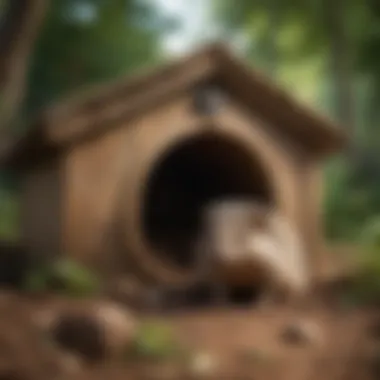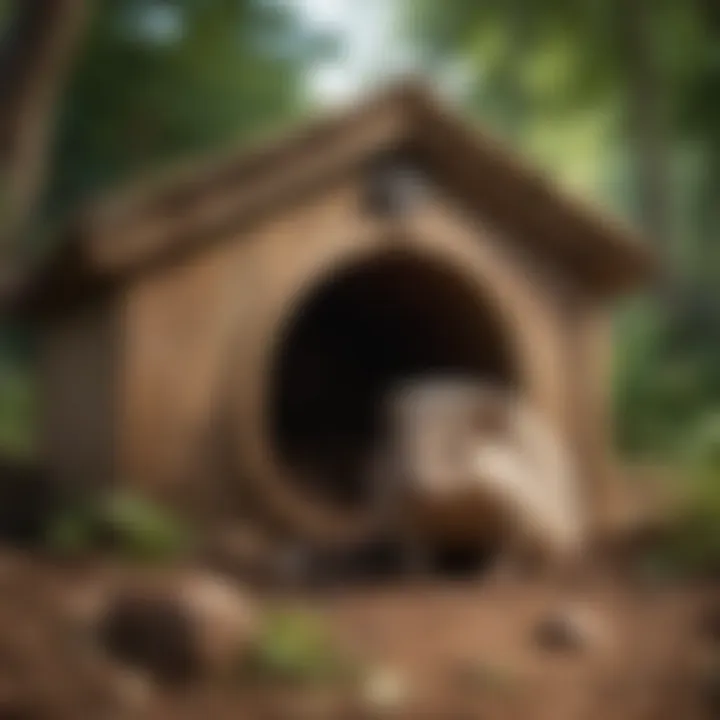Understanding the Optimal Habitat for Hedgehogs


Intro
Creating an optimal habitat for hedgehogs requires understanding their unique needs and behavioral patterns. Hedgehogs are nocturnal creatures, and they thrive in environments that offer both shelter and foraging opportunities. Developing a deeper comprehension of what constitutes their ideal habitat can aid in both their conservation and overall welfare. This article will explore various facets of hedgehog habitats, including essential care tips, nutrition guidelines, and insights on their behavior. By delving into these aspects, we hope to provide valuable information for individuals who wish to support hedgehogs in their own gardens or natural settings.
Care Tips
Daily Care Routines
Daily care for hedgehogs involves monitoring their behavior and health. It is valuable to check their environment for cleanliness. Ensure fresh water is always available. The food should be appropriate for their dietary needs, which can vary depending on the species. Taking note of their activities can highlight any changes in behavior.
Cage Setup and Maintenance
For hedgehogs kept indoors, having a proper cage is crucial. A spacious cage allows them to explore and move freely. The substrate should be suitable for burrowing, such as shredded paper or aspen shavings. It is important to provide hiding spots using cardboard boxes or tunnels, as these mimic their natural environment. Maintain a consistent temperature and reduce drafts to help them feel secure.
Hygiene and Cleaning Practices
Cleaning the habitat is essential to prevent odor and disease. Start with regular spot cleaning to remove waste. Deeper cleaning should occur weekly or biweekly. This involves removing all bedding, cleaning surfaces with mild soap, and replacing the bedding. Ensure all items in the habitat are also sanitized. Avoid using harsh chemicals that can harm hedgehogs.
Seasonal Care Adjustments
As seasons change, so do the needs of hedgehogs. During winter, they may require additional bedding for warmth. In warmer months, ensure they have access to cooler areas. If hedgehogs are outside, creating sheltered spots from rain and direct sunlight is necessary. Regularly check to ensure they have sufficient food, especially during periods when natural food sources may be scarce.
Behavioral Insights
Understanding Hedgehog Behavior
Observing hedgehog behavior provides insights into their health. A healthy hedgehog will be active during the night and will display curiosity about its surroundings. If they become lethargic, it might indicate a health issue that needs attention.
Common Behavioral Issues and Solutions
Some behavior issues can arise in captivity. For example, a hedgehog may become too aggressive if it feels threatened. Providing a safe and quiet space is essential to reduce stress. Handler patience and gentle interaction can alleviate aggression.
Positive Reinforcement Techniques
Using positive reinforcement can build trust between the owner and the hedgehog. Treats can be offered for good behavior or as part of a training regimen. This can improve the hedgehog’s social skills and encourage more confident interactions.
Social Interaction Needs
While hedgehogs may not require extensive socialization like other pets, regular interaction is still important. Spend time with your pet in low-stress situations. Allow them to explore your lap or surroundings without rushing them. This helps in building a connection.
Nutrition Guides
Essential Diet Components
Hedgehogs require a balanced diet. High-quality commercial hedgehog food forms the base of their diet. Additionally, protein sources like cooked chicken or insects can be offered. Fresh fruits and vegetables should be given in moderation.
Safe and Toxic Foods
Certain common foods are safe for hedgehogs, while others can cause harm. Safe options include cooked sweet potato and apples. Foods like chocolate, onions, and garlic are toxic. Ensure to educate yourself on these distinctions.
Supplements and Treats
In some cases, dietary supplements can enhance nutritional intake. Consult with a vet to determine which are appropriate. Treats can also be given cautiously, ensuring they are beneficial and not overly fatty or sugary.
Feeding Strategies for Different Species
Diet needs may vary slightly based on species. For instance, African pygmy hedgehogs may have different requirements than European hedgehogs. Always assess specific dietary needs and make adjustments accordingly.
Wellness and Health
Routine Health Checkups
Regular veterinary checkups help monitor a hedgehog’s health. These checkups can catch potential issues early on.
Identifying Symptoms of Illness
Understanding common health concerns is key. Symptoms like lethargy, changes in appetite, or abnormal behavior can indicate illness. Take prompt action if these signs appear.
Preventative Care and Vaccinations
Vaccinations may be necessary for specific diseases. Consult a veterinarian regarding what is recommended based on your location and the hedgehog’s lifestyle.
Mental and Emotional Well-being
Mental stimulation is just as important as physical health. Providing toys and varied environments can prevent boredom. A happy hedgehog is typically healthier overall.
Enriching Activities


Toys and Playtime Ideas
Playtime is vital in keeping a hedgehog engaged. Soft toys or tunnels can be provided for exploration. Simple games encourage movement and activity.
Training and Tricks
Training can strengthen the bond between owner and pet. Simple tricks can often be taught using treats as rewards.
Outdoor Activities and Interaction
Supervised outdoor time can expose hedgehogs to natural stimuli. Always ensure safety from predators and hazards.
DIY Projects for Mental Stimulation
Craft projects such as homemade toys can stimulate natural instincts. Simple designs using safe materials can enhance their environment physically and mentally.
Creating a suitable habitat is one of the best ways to ensure a hedgehog's health and happiness.
Preface to Hedgehog Habitats
In discussing the habitats suitable for hedgehogs, it is crucial to comprehend the specific environment these creatures thrive in. Hedgehogs, as a species, are sensitive to changes in their surroundings and require certain conditions to ensure their health and population stability. Their natural habitats influence not only their physical well-being but also their behavioral patterns and reproduction.
Importance of Habitat for Hedgehogs
The habitat serves as a critical foundation for the life of a hedgehog. It impacts their ability to forage, mate, and evade predators. Well-structured habitats typically provide a diverse range of food sources, including insects, slugs, and fruits. Moreover, habitats should offer shelter options, such as dense vegetation or leafy debris, allowing hedgehogs to retreat and rest during the day.
A suitable habitat not only supports individual hedgehogs but also contributes to the resilience of the population as a whole. Preservation of these environments helps protect the species from external threats, including habitat destruction and climate change. As obligate nocturnal foragers, hedgehogs thrive in environments where they can navigate safely at night without excessive disturbance.
Hedgehog Conservation Status
The conservation status of hedgehogs varies by region, often classified as a species of concern due to declining numbers in many areas. Factors leading to their decrease include urban expansion, road construction, and agricultural practices that destroy their habitats.
According to the International Union for Conservation of Nature (IUCN), hedgehogs face several threats, which necessitate immediate attention and action. Conservation efforts are focused on habitat restoration, ensuring food availability, and legal protections to mitigate human impacts on their ecosystems. Understanding the conservation status can be crucial for individuals engaged in ecological studies, wildlife conservation, or community-based environmental projects.
"Protecting hedgehog habitats is vital not only for their survival but also for maintaining biodiversity and ecosystem health."
Establishing awareness and active participation in hedgehog conservation can lead to improved habitat conditions. This knowledge can empower communities to advocate for ecological changes and implement effective strategies to support these unique animals.
Defining Hedgehog Habitat Requirements
Understanding the habitat requirements of hedgehogs is crucial for their well-being. These small mammals need specific conditions to thrive, which include elements such as shelter, food, and water. Defining these requirements is not just about creating a comfortable living space; it is also about ensuring their survival. By recognizing what makes an environment suitable for hedgehogs, one can contribute to their conservation and health.
Essential Habitat Elements
Natural Shelter
Natural shelter provides an essential refuge for hedgehogs. It includes features such as dense vegetation, piles of leaves, and even brush piles. These areas offer protection from predators and harsh weather. The key characteristic of natural shelter is its complexity. It allows hedgehogs to find safety while also being hidden from passersby. This natural choice is ideal for a hedgehog's survival as it mimics their wild habitat.
The unique feature of natural shelter is its adaptability. Such spaces can change with the seasons, offering varying degrees of cover throughout the year. However, one disadvantage could be that, if not maintained, they may become compacted or dry, reducing their effectiveness.
Food Sources
Food sources play a pivotal role in a hedgehog's habitat. These nocturnal creatures primarily feed on insects, snails, and worms. Accessibility to diverse food options is vital. A habitat rich in these food sources increases the likelihood that hedgehogs will thrive there, leading to healthier populations.
The key characteristic of food sources is their variety. A balanced diet is essential for hedgehogs to maintain their health. This not only enhances their growth but also aids in reproduction. A unique feature of food sources in a hedgehog's habitat is the presence of organic material, which fosters a rich ecosystem. However, an overly managed habitat that relies heavily on chemical fertilizers might reduce beneficial insects, impacting food availability negatively.
Water Availability
Water availability is another fundamental requirement for hedgehogs. They need to stay hydrated, particularly in arid conditions. A reliable water source boosts a habitat's quality. This can range from natural ponds to garden birdbaths, providing hedgehogs with opportunities to drink.
The key characteristic of water availability is its accessibility. Stagnant ponds may become breeding grounds for mosquitoes, but well-maintained water sources can enrich a garden ecosystem. A unique feature is the option to create shallow water dishes for hedgehogs. They present a risk, as too deep water might lead to drowning. Thus, ensuring a balance is crucial to keep hedgehogs safe while meeting their hydration needs.
Types of Suitable Environments
Woodlands
Woodland environments are ideal for hedgehogs due to their natural structure. The dense undergrowth of trees and shrubs provides excellent shelter. Woodlands also maintain a favorable microclimate, helping to moderate temperatures. These areas are rich in wildlife, offering ample food sources.
The key characteristic of woodlands is biodiversity, which creates a balanced ecosystem. They are considered a beneficial habitat as they support various species, including insects that hedgehogs prey upon. One potential disadvantage, however, is the risk of habitat loss due to development or forestry practices.
Grasslands
Grassland ecosystems also offer significant benefits. They provide open spaces that enable hedgehogs to forage. The seasonal dynamics of food availability in grasslands contribute positively to hedgehog survival. During spring and summer, the abundance of insects can support healthy populations.
The key characteristic of grasslands is their openness. This environment allows for easy movement and foraging. However, a unique challenge is the threat from predators found in more open areas. In addition, dry conditions in grasslands can limit food and water availability in certain seasons, posing risks to hedgehogs.
Urban Areas


Urban areas present unique conditions for hedgehogs. Adaptations to urban settings are notable as hedgehogs can find food in gardens and parks. Many city gardens provide a patchwork of habitats that can support hedgehogs if managed well.
The key characteristic of urban areas is their varied landscapes. They often contain smaller gardens that serve as micro-habitats. However, one major downside is the presence of traffic hazards. Urban pollution can impact food sources and overall health, making it essential to evaluate urban habitats critically.
In summary, defining hedgehog habitat requirements reveals the intricate balance needed to support their populations. By understanding these elements and environments, everyone can contribute to creating spaces that nurture hedgehogs effectively.
Natural Habitats for Hedgehogs
Natural habitats play a fundamental role in the overall well-being and survival of hedgehogs. These environments provide vital resources such as shelter, food, and areas for breeding. In their natural state, hedgehogs thrive in ecosystems that offer rich biodiversity and adequate protection from predators. The focus on natural habitats underscores the importance of maintaining ecological balance, which is crucial not just for hedgehogs but for the health of the entire ecosystem.
Natural habitats also reflect the hedgehog's adaptive behaviors. They positively influence hedgehog behavior, especially in mating and foraging. Adding to this, awareness about these habitats contributes to conservation efforts, ensuring that hedgehogs can continue to play their significant role in the ecosystem.
Woodland Environments
Woodlands offer a myriad of benefits to hedgehogs. The complex structure of woodland habitats provides ample cover, from dense undergrowth to various plant forms. This environment supports a diverse range of flora which has great interdependence with hedgehog survival.
Flora Interaction
Flora interaction is crucial in woodland environments. Hedgehogs depend on specific plants for both food and shelter. For instance, dense vegetation offers hiding spots where hedgehogs can evade predators. This characteristic makes woodlands a beneficial habitat, allowing hedgehogs to forage safely for insects and other invertebrates.
The diversity of flora also directly affects the food web. Many plants provide a source of nutrients vital for hedgehogs. However, not all flora is equally beneficial. Some can be invasive and disrupt the natural balance, leading to resource competition that can negatively impact hedgehogs.
Microclimate Benefits
Microclimate benefits in woodlands are notable. The canopy created by trees stabilizes temperature and humidity. These conditions help retain moisture in the soil, which encourages the growth of food sources like beetles and worms. The sheltered conditions mean that hedgehogs can be more active during different seasons without risking exposure to harsh weather.
A stable microclimate reduces stress on hedgehogs and increases their chances of survival, especially when they navigate for food. However, changes in tree cover due to deforestation can disturb these microclimates, leading to challenges for hedgehog populations.
Grassland Ecosystems
Grassland ecosystems, while less complex than woodlands, offer vital resources for hedgehogs. They provide more open spaces for foraging and nesting, making them an essential habitat type worth exploring.
Seasonal Food Dynamics
Seasonal food dynamics in grasslands are critical. Availability of food sources can shift dramatically throughout the year. During spring and summer, grasses and flowering plants produce a plethora of insects, which serve as key food for hedgehogs. The seasonal abundance can support higher hedgehog populations.
However, a decline in these food sources during autumn and winter poses a risk. Hedgehogs must adapt to these cycles for survival. Learning about seasonal dynamics can help in understanding how to manage local grasslands for their benefit.
Predator Avoidance
Predator avoidance is another significant aspect of grassland ecosystems. The open landscape can pose risks, but hedgehogs have adapted to these by utilizing foraging strategies to limit exposure. They often forage during twilight hours when predators are less active.
This unique feature of predator avoidance is advantageous, allowing hedgehogs to find food while minimizing danger. Nonetheless, in heavily urbanized areas, these grazing ecosystems can become fragmented, increasing vulnerability to predators and risks of predation.
Urban Habitats and Hedgehogs
Urban environments can be challenging yet surprisingly suitable for hedgehogs. With the expansion of urban areas, there is an increasing need to understand how hedgehogs adapt and thrive in these compact spaces. Key considerations include food sources, shelter availability, and the dangers inherent in city living. Urban habitats offer unique challenges but also great opportunities for hedgehog conservation if planned appropriately.
Adaptations to Urban Settings
Food Source Variability
Hedgehogs in urban settings often benefit from food source variability, as human activity creates diverse food options. This adaptability is crucial for their survival. In urban regions, discarded food, gardens, and other ecological pockets provide hedgehogs with access to different types of food, such as insects, worms, and even pet food left outside. These food sources become particularly important during colder months when natural food supply diminishes.
The key characteristic of food source variability is its abundance and accessibility. Urban gardens often grow native plants that attract insects, which hedgehogs feed on. This feature makes urban areas a beneficial choice for hedgehogs, as it supports their dietary needs. However, reliance on human-provided food can be a double-edged sword. Overdependence might pose a risk if food sources become scarce or inconsistent.
Unique Shelter Opportunities
Urban settings also provide unique shelter opportunities for hedgehogs. Gardens, parks, and even clutter in urban backyards can serve as suitable habitats. Well-structured gardens with native flora can offer dense cover for hedgehogs, shielding them from predators and extreme weather conditions.
The defining characteristic of these unique shelter opportunities is their manifold nature. Structures such as compost heaps, piles of leaves, or even stone walls serve as potential nesting sites. This is beneficial, as it promotes hedgehog safety during their active hours. However, some urban shelters may not provide adequate security against common urban predators like cats or dogs.
Challenges in Urban Environments
Traffic Hazards
One of the significant challenges in urban settings for hedgehogs is traffic hazards. Urban development typically leads to increased vehicle traffic, which poses a direct risk to hedgehogs wandering onto roads. This issue is critical as many hedgehogs are injured or killed in road accidents, significantly impacting their populations.
The key characteristic of traffic hazards is their unpredictability. Even short distances traveled can pose lethal threats. The presence of roadways fragmentizes their habitats, limiting their movement and access to essential resources. Raising awareness about this problem is vital for hedgehog conservation efforts. Better planning of urban environments can help mitigate these risks, such as creating wildlife crossings or reducing speed limits in areas frequented by hedgehogs.
Pollution Impact
Pollution is another pressing challenge faced by hedgehogs in urban environments. Chemical exposure from pesticides, waste, and vehicular emissions poses serious risks to their health. These pollutants can affect both food sources and living conditions.
A significant characteristic of pollution impact is its pervasive nature. While pollution is a problem in various environments, its concentration is often higher in urban areas. This can lead to a decrease in suitable food sources, as many hedgehogs rely on insects that may accumulate harmful substances. Preventing pollution through community efforts can protect hedgehogs and their habitats, ensuring healthier urban landscapes for their survival.
"Creating a hedgehog-friendly urban habitat involves understanding both their needs and the challenges posed by city living."


By recognizing and mitigating the factors discussed, urban habitats can indeed become supportive environments for hedgehogs. Through proper care, awareness, and urban planning, humans can greatly improve the chances of hedgehogs thriving in our cities.
Creating Ideal Habitats
Creating ideal habitats for hedgehogs is critical for their survival and thriving. This section explores how specific elements contribute to effective environments, while considering the needs of hedgehogs. By designing proper habitats, we can boost their health and populations. These habitats provide shelter, food, and safety from predators, which are essential for hedgehogs.'
Designing a Garden for Hedgehogs
Native Plant Integration
Incorporating native plants in a garden for hedgehogs can enhance habitat quality. Native plants are well-adapted to the local environment. They provide food and shelter to hedgehogs. Choosing native species supports local ecosystems and encourages biodiversity.
Moreover, these plants require less water and fewer chemical treatments than non-native species. Thus, they promote a healthier environment. When hedgehogs feel secure due to proper vegetation, they are likelier to inhabit the area. This can lead to a more flourishing hedgehog population, benefiting the overall ecosystem.
Habitat Zones
Establishing habitat zones is essential in creating a diverse garden. Habitat zones can include areas for foraging, nesting, and shelter. Each zone serves a different purpose for hedgehogs. For example, a foraging zone can have open spaces with good food sources. A nesting zone can provide dense cover with shrubs or leaves.
Designing these zones allows hedgehogs to thrive in a micro habitat suited to their behaviors. It can offer advantages like easier access to resources, minimizing competition. However, careful consideration is needed to ensure zones are appropriately spaced and maintained.
Ensuring Shelter and Safety
Construction Tips for Hedges and Burrows
Building hedges and burrows is a key aspect of providing shelter. Hedges should be dense and thorny to deter predators while providing a safe retreat. The design should allow hedgehogs to enter and exit easily. Creating burrows with natural materials promotes comfort and safety.
These constructions should be well-placed in quiet and shaded areas. Having enough shelter ensures hedgehogs can escape harsh weather conditions. In addition, well-constructed shelters can increase hedgehog presence in the area, promoting population stability.
Preventing Predation Risks
Preventing predation risks is crucial for hedgehogs' safety. Natural predators like foxes or domestic pets can threaten hedgehogs. Implementing good garden design can reduce such risks.
Fencing and barriers may be beneficial in restricting access to vulnerable areas. Additionally, educating the community on responsible pet ownership can further the cause. When hedgehogs feel less threatened, they are more likely to breed and survive.
Creating ideal habitats directly impacts hedgehog populations and health. Careful design and consideration of safety factors contribute significantly to hedgehogs’ needs.
Monitoring Hedgehog Populations
Monitoring hedgehog populations is essential for understanding their behavior, health, and environmental needs. This aspect gives insight into their habitat preferences, reproductive success, and threats they face. By keeping track of these populations, conservation efforts can be informed and targeted effectively. It can also help identify areas where hedgehogs thrive and those where they struggle, allowing for more tailored conservation strategies.
Tracking and Observation Methods
Use of Cameras
Using cameras for monitoring hedgehogs provides a non-intrusive method to gather data. This technology enables researchers to observe hedgehog behavior in their natural habitat without disturbing them. One key characteristic of using cameras is their capability to capture images and videos at various times. This is beneficial because researchers can analyze activities like foraging or mating.
One unique feature of this method is the ability to use motion-activated cameras. They only capture images when movement is detected. This minimizes battery use and storage needs. However, there are disadvantages; for example, they may miss activities if the hedgehog does not move into the camera’s field of view. Moreover, the initial setup can be time-intensive.
Field Surveys
Field surveys are another effective method to monitor hedgehog populations. Surveys involve direct observation and data collection on hedgehogs and their habitats. A key characteristic of field surveys is their versatility. They can be conducted in various environments, from rural to urban settings. This adaptability makes them a popular choice.
Field surveys allow researchers to gather firsthand data about hedgehog numbers, movements, and habitat conditions. A unique feature is the ability to assess multiple variables such as food sources and shelter availability. These factors directly impact hedgehog well-being. However, field surveys can be labor-intensive, requiring significant time and manpower. Weather conditions can also affect results.
Community Involvement and Awareness
Local Conservation Efforts
Community involvement is crucial for local conservation efforts aimed at hedgehogs. These initiatives often include habitat restoration and public workshops. A key characteristic is that they foster collaboration between local authorities and residents. This cooperation can enhance habitat quality, ensuring that hedgehogs have the space they need to thrive.
Local conservation efforts can also educate the public on hedgehog habits and the challenges they face. One unique feature is that community-driven projects often bring together volunteers, thereby promoting a sense of community. However, a challenge can arise when there is a lack of awareness or interest from the community, which can hinder the effectiveness of these efforts.
Public Education Campaigns
Public education campaigns play a vital role in raising awareness and knowledge about hedgehogs. These campaigns inform the public about hedgehog habitats, their needs, and how people can help. A key characteristic is their broad reach; often utilizing social media, flyers, and local events. This wide dissemination of information is beneficial as many people may not be aware of hedgehogs' needs.
A unique feature of public education campaigns is their ability to create a sense of urgency and connection to the issue. By sharing stories of hedgehogs in their locality, campaigns can motivate individuals to participate in conservation efforts. However, one of the disadvantages is that they may require ongoing funding and resources to maintain momentum.
Closure
The conclusion serves as a pivotal component in this article. It encapsulates the essential themes discussed throughout and emphasizes the significance of understanding hedgehog habitats. Recognizing the specific habitat needs of hedgehogs not only aids in enhancing their well-being but also encourages proactive conservation efforts.
Summary of Key Points
- Hedgehog habitats must provide essential elements like shelter, food, and water.
- Natural environments include woodlands and grasslands, which fulfill these needs effectively.
- Urban areas pose unique challenges but also offer opportunities for creating favorable conditions through thoughtful garden design.
- Community involvement plays a critical role in monitoring populations and raising awareness.
By synthesizing these details, we clarify the requirements for suitable hedgehog habitats. This understanding allows individuals and communities to positively impact hedgehog conservation efforts.
Future Considerations for Hedgehog Habitat
To ensure the future survival of hedgehogs, it is important to consider ongoing changes in their habitats. Urbanization, climate change, and agricultural practices have profound effects on their environments. Key considerations include:
- Implementing more wildlife corridors in urban planning to connect fragmented habitats.
- Advocating for sustainable agricultural practices that maintain hedgehog-friendly environments.
- Engaging local communities in habitat restoration projects to increase available natural shelter.
By addressing these factors, stakeholders can enhance the ecological balance, ensuring hedgehogs continue to thrive in various environments. The collective efforts in understanding and creating optimal habitats will ultimately contribute to the species' future and facilitate their coexistence with human activities.















